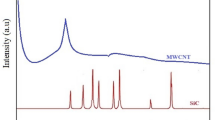Abstract
Amorphous silicon nitride fibers were characterized with respect to their chemical and phase compositions. The high-temperature behavior of the fibers was investigated in N2 and Ar at temperatures ranging from 1350 to 1600 °C through tensile tests, pore volume analysis, elemental analysis, weight loss, X-ray diffraction, and scanning electron microscopy to elucidate the effects of the atmosphere on the fiber degradation mechanism. The fibers demonstrated better high-temperature stability in N2 instead of Ar. In particular, the fibers heat-treated in N2 at 1450 °C retained 43% of their original strength (0.64 GPa), while the fiber strength was completely lost in Ar at the same temperature. The primary reason for the strength degradation of the amorphous fibers was the expanding nanopores before the formation of the large Si3N4 grains. However, a catastrophic decrease in strength was due to the drastic thermal decomposition of SiNxOy and crystallization of Si3N4 grains, influenced by N2 pressure. Thermodynamic considerations were additionally applied to estimate the decomposition and carbothermal decomposition of crystalline Si3N4, thereby explaining the significant discrepancy of crystallization transformation at 1600 °C under different atmospheres.









Similar content being viewed by others
References
Krstic Z, Krstic VD (2012) Silicon nitride: the engineering material of the future. J Mater Sci 47:535–552. doi:10.1007/s10853-011-5942-5
Hector AL (2016) Synthesis and processing of silicon nitride and related materials using preceramic polymer and non-oxide sol-gel approaches. Coordin Chem Rev 323:120–137
Zou CR, Zhang CR, Li B, Wang SQ, Xie ZF, Song YC (2015) Fabrication and properties of borazine derived boron nitride matrix wave-transparent composites reinforced by 2.5 dimensional fabric of Si–N–O fibers. Mat Sci Eng A 620:420–427
Yokoyama Y, Nanba T, Yasui I, Kaya H, Maeshima T, Isoda T (1991) X-ray diffraction study of the structure of silicon nitride fiber made from perhydropolysilazane. J Am Ceram Soc 74:654–657
Funayama O, Nakahara H, Tezuka A, Ishii T, Isoda T (1994) Development of Si–B–O–N fibres from polyborosilazane. J Mater Sci 29:2238–2244. doi:10.1007/BF01154704
Kamimura S, Seguchi T, Okamura K (1999) Development of silicon nitride fiber from Si-containing polymer by radiation curing and its application. Radiat Phys Chem 54:575–581
Mocaer D, Pailler R, Naslain R, Richard C, Pillot JP, Dunogues J, Delverdier O, Monthioux M (1993) Si–C–N ceramics with a high microstructural stability elaborated from the pyrolysis of new polycarbosilazane precursors - Part III Effect of pyrolysis conditions on the nature and properties of oxygen-cured derived monofilaments. J Mater Sci 28:2639–2653. doi:10.1007/BF00356198
Baldus P, Jansen M, Sporn D (1999) Ceramic fibers for matrix composites in high-temperature engine applications. Science 285:699–703
Thommes M, Kaneko K, Neimark AV, Olivier JP, Reinoso FR, Rouquerol J, Sing KSW (2015) Physisorption of gases, with special reference to the evaluation of surface area and pore size distribution. Pure Appl Chem 87:1051–1069
Neimark AV, Ravikovitch PI (2001) Capillary condensation in MMS and pore structure characterization. Micropor Mesopor Mat 44–45:697–707
Neimark AV, Ravikovitch PI, Vishnyakov A (2003) Bridging scales from molecular simulations to classical thermodynamics: density functional theory of capillary condensation in nanopores. J Phys: Condens Matter 15:347–365
Goto T, Itoh F, Suzuki K, Hirai T (1983) ESCA study of amorphous CVD Si3N4–C composites. J Mater Sci Lett 2:805–807. doi:10.1007/BF00720564
Funayama O, Nakahara H, Okoda M, Okumura M, Isoda T (1995) Conversion mechanism of polyborosilazane into silicon nitride-based ceramics. J Mater Sci 30:410–416. doi:10.1007/BF00354405
Cao SY, Wang J, Wang H (2016) High-temperature behavior and degradation mechanism of SiC fibers annealed in Ar and N2 atmospheres. J Mater Sci 51:4650–4659. doi:10.1007/s10853-016-9780-3
Widgeon S, Mera G, Gao Y, Sen S, Navrotsky A, Riedel R (2013) Effect of precursor on speciation and nanostructure of SiBCN polymer-derived ceramics. J Am Ceram Soc 96:1651–1659
Pysher DJ, Goretta KC, Hodder RS, Tressler RE (1989) Strength of ceramic fibers at elevated temperature. J Am Ceram Soc 72:284–288
Barin I, Knacke O, Kubaschewski O (1977) Thermochemical properties of inorganic substances supplement. Springer, Berlin, pp 674–675
Chollon G, Vogt U, Berroth K (1998) Processing and characterization of an amorphous Si–N–(O) fibre. J Mater Sci 33:1529–1540. doi:10.1023/A:1017555518483
Singhal SC (1985) Thermodynamic analysis of the high-temperature stability of silicon nitride and silicon carbide. Ceram Int 2:123–130
Acknowledgements
This work is supported by the National Natural Science Foundation of China (No. 51203184) and the Aid Program for Science and Technology Innovation Research Team in Higher Educational Institution of Hunan Province.
Author information
Authors and Affiliations
Corresponding authors
Ethics declarations
Conflict of interest
There are no conflicts of interest to declare.
Rights and permissions
About this article
Cite this article
Hu, X., Shao, C., Wang, J. et al. Characterization and high-temperature degradation mechanism of continuous silicon nitride fibers. J Mater Sci 52, 7555–7566 (2017). https://doi.org/10.1007/s10853-017-0988-7
Received:
Accepted:
Published:
Issue Date:
DOI: https://doi.org/10.1007/s10853-017-0988-7




